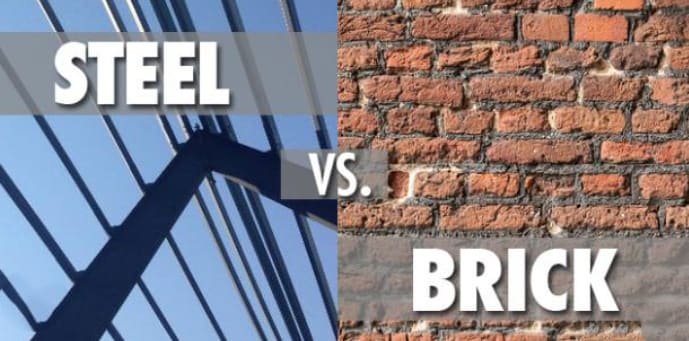When it comes to constructing buildings, the choice of materials can significantly impact the overall cost. Two popular options are steel and brick, each with its own set of advantages and considerations. Understanding the cost differences between steel buildings and brick buildings is crucial for anyone planning a construction project. This article examines the factors influencing the cost of steel and brick buildings and helps determine which option may be more cost-effective.
Initial Costs: Steel vs. Brick
One of the primary considerations in comparing steel and brick buildings is the initial cost of construction. Generally speaking, steel buildings tend to be more affordable than their brick counterparts.
Steel buildings are constructed using pre-fabricated steel components, which are manufactured in a factory and then assembled on-site. This prefabrication process not only reduces labor costs but also shortens the construction timeline. In contrast, brick buildings require the manual laying of each brick, which is labor-intensive and time-consuming. This results in higher labor costs and a longer construction period for brick buildings.
On average, steel buildings can cost between 10% to 30% less than brick buildings for the same size and design. The savings are attributed to the reduced labor and construction time required for steel structures. Additionally, steel’s high strength-to-weight ratio means that less material is needed to achieve the same structural integrity, further reducing costs.
Long-Term Costs and Maintenance
While steel buildings may have a lower initial cost, long-term costs and maintenance are important factors to consider. Steel buildings typically require less maintenance compared to brick buildings. Steel is resistant to issues such as rot, termites, and warping, which can affect brick structures over time. This durability means fewer repairs and replacements, translating into lower long-term maintenance costs for steel buildings.
Brick buildings, on the other hand, may require more frequent maintenance. Brickwork can be susceptible to issues such as cracking, spalling, and water damage, especially if not properly sealed and maintained. The need for repointing and occasional repairs can add to the long-term costs of brick buildings.
Energy Efficiency and Insulation
Energy efficiency is another critical factor in the cost comparison between steel and brick buildings. Brick buildings are known for their excellent thermal mass, which helps regulate indoor temperatures by absorbing and releasing heat slowly. This can lead to lower heating and cooling costs over time.
Steel buildings, however, often require additional insulation to achieve similar energy efficiency levels. While modern steel buildings can be designed with effective insulation systems, the added cost of these systems must be factored into the overall expense. In some cases, the cost of insulating a steel building to match the energy efficiency of a brick building can offset the initial savings on construction.
Environmental and Sustainability Considerations
Environmental impact is becoming an increasingly important factor in construction decisions. Steel is highly recyclable, and many steel buildings are constructed from recycled materials, making it a more sustainable option compared to brick. However, the production of steel can be energy-intensive and contribute to greenhouse gas emissions.
Brick, while not as recyclable as steel, is made from natural materials and has a long lifespan, which can contribute to its sustainability. The choice between steel and brick can also be influenced by local environmental regulations and sustainability goals.
Conclusion
In conclusion, steel buildings generally offer a more cost-effective solution in terms of initial construction costs compared to brick buildings. The prefabrication of steel components reduces labor and construction time, leading to lower upfront expenses. However, when considering long-term costs, maintenance, and energy efficiency, the differences become more nuanced.
Steel buildings may require more insulation to match the energy efficiency of brick buildings, and maintenance costs are generally lower for steel. Environmental considerations also play a role in the decision-making process. Ultimately, the choice between steel and brick will depend on individual project requirements, budget constraints, and long-term goals.
For those looking to minimize initial costs, steel buildings are likely the more economical choice. However, for projects where long-term durability, energy efficiency, and sustainability are top priorities, brick buildings may offer advantages that justify the higher initial investment.
Post time: Sep-12-2024




